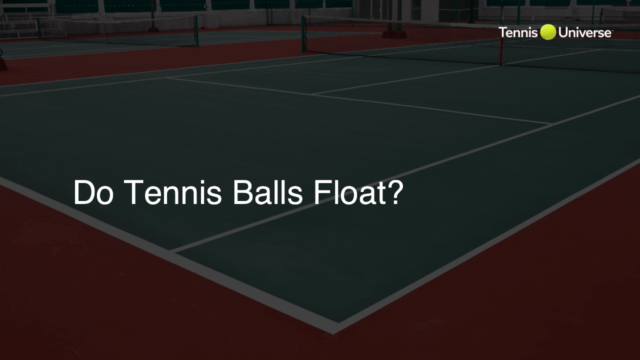Tennis balls are pressurized to maintain optimal bounce, performance, and playability. Pressurization helps the ball retain its elasticity and shape, allowing it to return to its original form quickly after being struck. The internal air pressure also contributes to the ball’s liveliness on the court, providing better rebound and spin when the tennis ball is in play.
Understanding Pressurized Tennis Balls
Pressurized tennis balls have internal air pressure that gives them optimal bounce, performance, and playability. This pressurization is essential for retaining the ball’s shape and elasticity, resulting in a livelier game and improved player experience.
Importance of Pressurization in Tennis Balls
Bounce and Rebound
The internal air pressure of a tennis ball directly affects its bounce and rebound properties. A pressurized ball tends to have a more consistent and higher bounce, allowing for greater control and precision during play. This translates to longer rallies and more engaging tennis matches.
Spin and Response
Pressurized tennis balls exhibit better response to a player’s tennis racket due to their elastic nature. This allows the ball to grip the racket strings effectively and generate more spin during shots, giving the player greater control in directing the ball’s trajectory and outmaneuvering their opponent.
Durability and Playability
Pressurization helps to maintain the tennis ball’s structural integrity over time. As a player repeatedly hits the ball with their tennis racket, the internal air pressure counteracts external forces and ensures that the ball retains its shape and performance qualities. This maintains the ball’s playability and prolongs its lifespan on the court.
Decompression of Tennis Balls
Over time, pressurized tennis balls lose their internal air pressure, leading to a decrease in bounce and liveliness. As the internal pressure decreases, the ball becomes less responsive, eventually requiring replacement with a new, pressurized tennis ball to maintain consistent game play.
Types of Tennis Balls
There are two main types of tennis balls: pressurized and pressureless. Each type has its advantages and disadvantages, and understanding their differences will help you choose the right ball for your game.
Pressurized Tennis Balls
As previously discussed, pressurized tennis balls are known for their optimal bounce, performance, and playability. They are ideal for competitive play and provide excellent response and feel. However, they tend to lose their internal pressure over time, which affects their performance and may require frequent replacement.
Pressureless Tennis Balls
Pressureless tennis balls do not contain pressurized air and instead rely on their rubber and felt construction to provide bounce. These balls offer more consistent performance over time and are less prone to pressure loss. However, they might feel heavier and less lively compared to pressurized balls, making them more suitable for practice sessions and recreational play than high-level competition.
Tennis Tips: Choosing the Right Tennis Ball
When selecting a tennis ball, consider your skill level, playing style, and preferences. Pressurized balls are great for players who prioritize performance, spin, and responsiveness, while pressureless balls are suitable for players who seek durability and consistency.
Effect of Altitude on Tennis Ball Performance
Altitude can significantly impact the behavior of pressurized tennis balls. At higher altitudes, the surrounding air pressure is lower, causing tennis balls to bounce higher and travel faster. There are specially designed high-altitude tennis balls with lower internal pressure to compensate for this effect and provide a more consistent playing experience.
Storing Pressurized Tennis Balls
Proper storage is crucial for maintaining the optimal performance of pressurized tennis balls. Keep them in their sealed, original packaging until ready for use. Once opened, it’s a good idea to use them within a few weeks, as exposure to air will gradually cause a loss of pressure. Additionally, keep your tennis balls away from extreme temperatures and humidity to prolong their lifespan.
FAQ Section
Below are some common questions and answers related to pressurized tennis balls, their benefits, and differences compared to other types of tennis balls:
Why do pressurized tennis balls lose their bounce over time?
Pressurized tennis balls lose their bounce due to gradual leakage of internal air pressure. As the pressure decreases, the ball becomes less elastic and its ability to rebound after being struck also diminishes, leading to a decline in performance and playability.
How can I tell if my tennis ball is pressurized or pressureless?
Pressurized tennis balls usually feel lighter and livelier than pressureless balls. Additionally, the packaging often indicates whether a ball is pressurized or pressureless. If still uncertain, you can test the bounce and feel of the ball during play, with pressurized balls typically providing a more rapid and higher bounce.
Are pressurized tennis balls always better than pressureless tennis balls?
Not necessarily. Choosing between pressurized and pressureless tennis balls depends on personal preferences and skill level. Pressurized balls offer livelier performance and better spin, suited for competitive play, while pressureless balls are durable and consistent, making them ideal for practice sessions and recreational play.
How should I properly store my pressurized tennis balls?
Store pressurized tennis balls in their original, sealed packaging until ready for use. Once opened, use them within a few weeks, as exposure to air will cause a gradual loss of pressure. Keep tennis balls away from extreme temperatures and humidity to maintain their quality and extend their lifespan.
Do all tennis tournaments use pressurized tennis balls?
Most professional tennis tournaments use pressurized tennis balls due to their superior bounce, performance, and responsiveness. However, the type of pressurized ball may differ depending on factors like court surface and altitude, with specific balls designed to adapt to these variable conditions.












